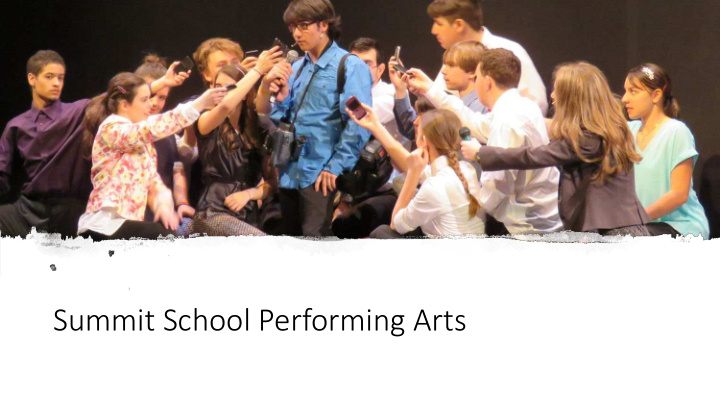



Summit School Performing Arts
Our Performing Arts program has two primary objectives: 1) To give the students a place to develop and What is express their creativity. 2) To reach out to the community and introduce Summit them to these wonderful, talented and unique individuals. School • It is a program managed by dedicated staff Performing members. • We have been producing shows since 2007 Arts? • Our shows have been put up at many of Montreal’s most celebrated stages.
Past Projects Summit: The Documentary 2003 • Produced with the NFB • Student’s interviewing each other. The Forgotten Ones 2005 • Pure imagination • Community involvement
Past Projects: We Are Daniel 2007 • Student’s Story • Elevating the work (Steven Atme) Based on true Feelings 2009 • Student’s Story • Confronting Controversy
Past Projects Rachel At Risk 2013 • Collective Storytelling • Powerful Points of View Being Rachel 2013-2018 • Documenting the Process • Giving the student’s context
Past Projects You’ll Never Walk Alone 2015 • Gala event, Ashley’s Surprise Outta Here 2016 • Musical, 50 Student actors, big production • Centaur Theatre, Wildside Festival
Letter to My Disability • Ester and the Letters • Ten Students, Ten Staff • Teacher’s Life • Parent’s perspective • Put up three times will many requests
Different Processes for Different Projects • Forgotten Ones • Oral • Four Students • Letter to My Disability • Began with Letters • Rachel at Risk • Over 50 students • Groups of 6-8 • Video Recording
Why Tell These Stories? STUDENTS AUDIENCE • Self Confidence • Redefining perceptions • Processing Experiences • Planting the seeds inside them • Discovering Identity • Social change (95%-5%) • They have something to say • Society is apathetic (mostly) • People want to listen • Hard for students to advocate
Empathy in Art • Kathryn Petersen gave a roadmaps to how to respond with empathy in tough situations. • Art can be training ground to develop these muscles. • Art expresses a unique point of view. How we understand out students. • Can have difficulty speaking, eye contact, etc. Artistic expression can be a way around this to find the person within.
Working With Students Creating Safe and Inviting Space in Group Setting - Non judgemental, redirect criticism of good/bad. Does not exist in art. - Art is P.O.V. Everything expressed should be looked at though the context of personal view point (even derivative ideas, highlights what student reacts to.) - Listen. Ask questions. Resist the urge to direct or suggest. - If a student needs help, ask other students for suggestion - Don’t assume anything. - In art, relevance is also subjective. Don’t worry about ideas that seem random… unpack them. - Unpacking them in an exercise in COGNITIVE EMPATHY.
Example of Autistic Person’s Thinking… • Word association: MICROWAVE
LEPRECHAUN www.wrongplanet.net
Thought Process… (associative thinking) • Microwave • Most interesting thing about a microwave is food exploding in it • The best exploding food is a potato • Potatoes are associated with the Irish • The most Irish thing I can think of is… • A LEPRECHAUN • Good to not disregard, but to ask: How did you come to that? • This kind of thinking may pose problems in day to day conversation, but in Art, associative thinking can be a BIG advantage.
Student Storytellers All students are storytellers. • Stories about what they did last night. • Stories about their family. • Stories about their childhood. • Stories about their friends. • Stories about how they’re in love with. • Stories about something bad that happened. Stories are often the first way they communicate with us about their most important feelings. LISTEN. Why are they telling me this story? Why are they telling it in this way? How do they describe themselves. They are the main characters in their stories.
Impatient Listening Common Modern world As listeners we responses to a trains us to talk want to hear fast! student telling a fast! story: “I’m busy right “Get to the point.” “Tell me later.” now.” You’re a But it is a story, not Later never comes. teacher, when are just information. you not busy?
The Brainstorm • Most important part of the process. • Complete freedom to express. • Try to get at least one idea from each student. • Freeflowing class, sometimes we don’t respect the “raise your hand rule” because it can be a barrier to spontaneous expression. • Students sometimes forget while the hand is raised. • Any idea is good. No guidelines. • No negative reactions to the ideas of others. • Good brainstorming is close to total chaos.
Step 3: Voting 1 2 3 4 5 Haunted Documentary: People Being Robot and School! morphing into Different! Alien Invasion Cars or School! animals! Attack of the Bullying monsters
• Most independent activity. • Often the most fun. Building • Distribute character worksheet. Characters! • Help with list of personality words. • Try to create original characters.
Characters as Proxies • Sometimes, characters can say or do or admit things that the student can’t. • Sometimes its conscious, sometimes its not.
• Find your theme • Find the central conflict • Create an outline • Beginning: define the central conflict Plot Building • Middle: reveal how the conflict has the power to overwhelm • End: Show how the main character resolves the conflict
End Product of Storytelling Project • Short Play • Song (rap, ballad) • Short Movie • Oral Presentation • Children’s Book • Puppet Show • Comic • Mural • Radio Play (Podcast) • Photo collage/story • Short Story • News Article • Webisode
Endings … • Find your audience • Understand your audience • Stagefright remedies (doing something important, group power!) • Processing audience response • Reaffirming confidence • Let them tell their stories about how the project impacted them • THANK YOU!!!
Recommend
More recommend